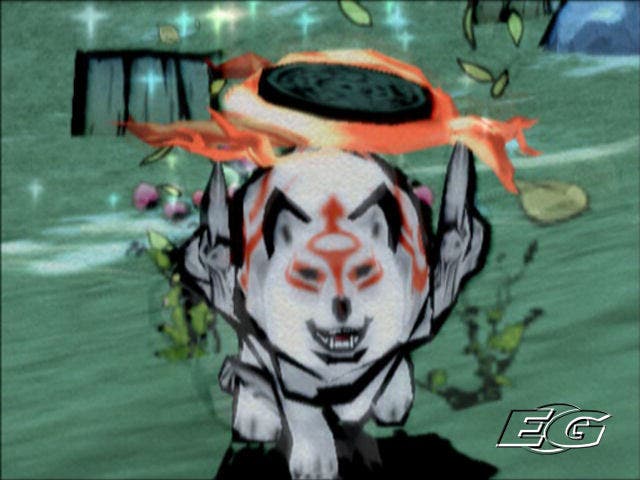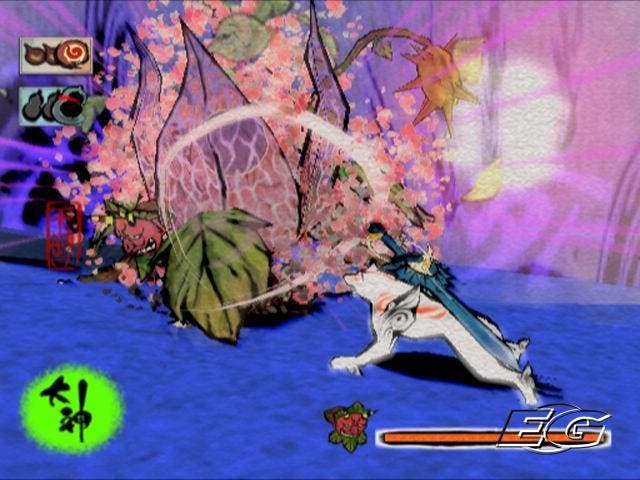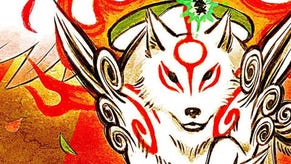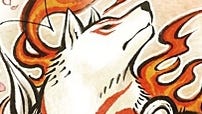Okami
Stroke of genius.
Once or twice a year a game like this comes along. A game so engrossing, so crafted and so life-affirming that nothing else in the world seems to matter. It's snowing outside, you say? Anna Nicole Smith's dead? England beat the Aussies? Meh. You're pregnant?! Hang on a minute, I've just got to finish off this section...
Trying to neatly extol the virtues of Okami's endless charms isn't an easy task. It's one of those gaming experiences with so many interesting quirks about it and so many magic moments that merely running through the back-story and explaining what you do won't give you a hope of relating to how special this game really is. At worst, going into too much detail could turn this into an anti-review.
Bite-sized synopsis? It takes all the best bits of Zelda (the structure, atmosphere, puzzles), throws in wonderfully original combat and the most adorable art style ever seen in a videogame. It's not just one of the most consistently engaging action adventures we've played, but one that feels utterly unique in many ways that matter. It really is an exceptional achievement on so many levels.
Turn on the bright lights

Unfortunately, it's a yet another game where the land has been engulfed in darkness by a nefarious evil force known as Orochi, and, yes, another one where it's up to you to sort out the whole sorry mess, rid the world of evil and allow the nice fluffy villagers to get on and lead their idyllic rural lifestyles.
On the flip side, how you go about playing the all-conquering hero is somewhat more interesting. To combat this rising tide of evil, an old statue of a white wolf, Okami, is infused with the life force of an ancient god called Amaterasu - who just happens to posses the power of the Celestial Brush. And if that weren't improbable enough, you're accompanied by an ill-mannered talking bug called Issun, who also happens to be a calligrapher.
Fittingly, the cel-shaded brush art style matches the game's focus on the Celestial Brush powers. What you see are arguably some of the most strikingly beautiful visuals ever found in a videogame - never mind on the humble PS2. Every scene is like a living ink and wash painting, with stunningly graceful pastel landscapes populated with buildings, wildlife and fauna that are lavished with an equal degree of crafted attention. As captivating as the gameplay undoubtedly is, the process of constant exploration benefits no end by the superhuman effort that Clover invested into the art direction and animation.
Restoring light and nature back into the game world isn't just something to satisfy the gamer in you - its floral carnival turns the game into some sort of interactive digital art gallery. Some of the effects that kick in whenever you've done Something Good are truly sights to behold, and hopefully will help no end in persuading people to buy the game in the first instance - even if they're wary of what the game's actually like.
The brush off

But what's just as important in making Okami stand out as Something A Bit Different is how much of the gameplay hinges on your mastery of the 15 Celestial Brush techniques. On a basic level it gives you the ability to see off enemies and deal with environmental puzzles by drawing on the screen. To begin with, you'll learn basics like Sunrise, which allows you to turn night into day by drawing a circle in the sky, and Rejuvenation, which lets you mend broken bridges and the like. But soon enough, more fundamental techniques like Power Slash creep into the gameplay, which not only help you cleave rocks and wooden obstacles in half, but give you more powerful options during combat.
At first, using the Celestial Brush techniques can feel a little clunky, mainly because reliably drawing straight lines and circles isn't as straightforward as it could have been. To make things easier, the game generally pauses (and goes into a sepia mode to emphasise the effect) when you hold R1 to draw, so there's usually no time pressure to draw a circle or a straight line. Allowing players to take their time over their brush strokes is definitely a key part of helping you get to grips with what is, after all, a very odd game mechanic to have thrust upon you. But with confidence and experience comes added responsibilities, and Okami is positively loaded with them.
At key intervals in the game you'll be rewarded with yet more techniques, such as the Cherry Bomb (to blow up enemies, cracked walls and so on), Bloom (to make withered flora and fauna blossom), Water Lilly (to allow you to traverse bodies of water), and Vine (to reach giant blossoms in high places). Later on, you'll learn even more advanced techniques that give you more control over the elements - without completely spoiling the vast number of treats in store for you. Regardless of the power of these techniques, though, pulling them off is always extremely simple, with just a simple stroke required in most cases. More often than not, context is key, with the game giving vital clues when drawing, such as colour-coded 'holy smoke' allowing you to know precisely what technique you can use on any given piece of scenery or enemy.


.png?width=291&height=164&fit=crop&quality=80&format=jpg&auto=webp)






